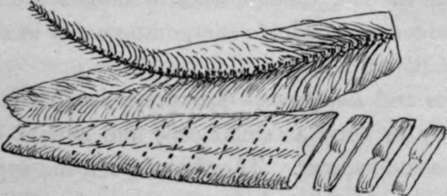Herring
Description
This section is from the book "Sea Fishing", by John Bickerdyke. Also available from Amazon: Sea Fishing.
Herring
This is a very valuable bait for most kinds of sea fish, and is often obtainable either from the fishmongers or the fishermen. In America it is pounded up and used as ground bait. It is particularly valuable for this purpose owing to its being an oily fish, the highly flavoured oil globules spreading about and doubtless attracting the fish, though one would certainly expect them to rise quickly to the surface.

HERRING PARTLY CUT UP FOR BAIT.
The soft roe of the herring has been recommended as a bait for grey mullet, but is very difficult to keep on the hook.
I have so often seen amateurs mangling herrings which they were cutting up for bait, that a short account of the process seems necessary. First chop off the head and tail of the fish ; next split it carefully down the back with a sharp 1 knife, and lay it open on the bait board. The head, tail, and inside, together with the backbone, all mixed up, are a valuable addition to the ground bait if any is being used. After carefully removing the bone, ribs, and guts, which will all come away together, divide the two halves down the stomach, and from each half cut off diagonal pieces as they are required about a quarter of an inch wide. The illustration will assist the understanding of this method. The dotted lines show where the knife should cut the uncut portions. Of course, if large conger or cod are being angled for, the baits must be cut larger. I generally put the hook in at the thin or belly end of the bait from the scales' side, then twist it round and put it again through the scales at the thick portion, the point coming out through the soft flesh. I have already referred to the use of bloaters as a bait for bass and eels.
1 Let me again say a pocket hone is simply invaluable when sea fishing, both for knife and hooks.
Horse Mackerel
This is a coarse kind of mackerel which is little used as bait, though, when flounders are wanting, it sometimes does service in lobster, crab pot, or in some prawn net. (See Chapter XI).
Continue to:
- prev: Garfish
- Table of Contents
- next: Lampreys And Lamperns
Tags
fishing, hooks, bait, fishermen, spanish mackerel, mackerel fishing
